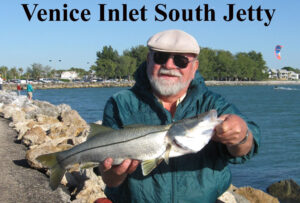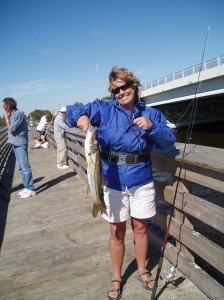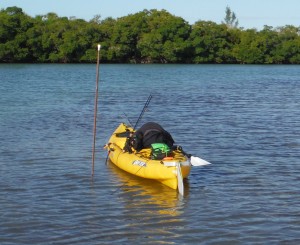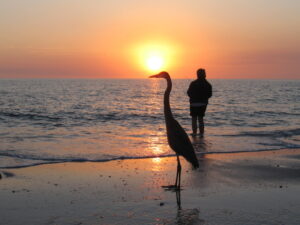Fishing blog: Tales of angling adventures from around the world
Welcome to our fish blog! Here you can read more sage advice from anglers around the world. This is the place for news, tips and non-fiction fish tales from mountain lakes to distant beaches. Please feel free to comment and join in on the conversations and share some fish tales of your own!
Winter or something like it finally arrived in Florida this week. During those windy days with temperatures in the 50’s, only the hardy ventured out on the piers and beaches. These cold fronts cause rapid changes in water temperature that can put fish in survival mode and not a feeding mood. Just as if you were thrown into cold water, your first reaction would not be hunger. The shallows chill faster which forces the fish into deeper channels but doesn’t improve their appetite. Sheepshead seem to be immune to this pattern and continue to provide sport for the hardy pier anglers.
The best part is that as water temperatures rise following a cold snap, fish immediately resume their never ending search for a meal. Initially, waters rise in the protected bays and canals with dark bottoms and seawalls. Soon after, these warmer waters begin to work their way into the larger bays with outgoing tidal flow. Use this to predict where game fish might congregate. Protected, south facing mangrove shorelines adjacent to flats with slightly deeper water close to the trees are perfect examples. If you can find some with oyster shell nearby and a layer of dark colored, decomposing mangrove leaves on the bottom, even better. This is where the bait fish, especially juvenile mullet, will be [closely followed by predators].
Access to protected shorelines with mangroves is tough for the angler fishing from shore. Seawalls can be a little easier to find but tend to be on private land. Wading is an excellent option here as long as you find a firm sandy bottom, not bottomless mud. This time of year, the water is pretty chilly, usually in the low 60’s so waders may make your day a little warmer. Assuming a northerly wind in the winter associated with cold fronts, here are a few idea for the best fishing in Florida, most of which are featured in our book “Angler’s Guide to Shore Fishing Southwest Florida-Longboat Key to Boca Grande” available at many fine stores in this area and on our website at www.anglerpocketguides.com
• The small bay at northeast end of Big Sarasota Pass warms quickly and flushes this warm water into the pass on outgoing tides. This area is more protected from a northwest wind.
• The north side of Longboat Pass protected by trees. Check out the east side, particularly the area protected by Leffis Key. This area has a sandy bottom and warms quickly near shore.
• The shoreline on the southern side of Cedar Point Environmental Park
• The north side of New Pass especially the bay west of the parking lot and the shoreline east of the bridge. Both areas have shallow warm water entering the channel and have sandy wadable bottom.
• The north side of the Venice Inlet on the beach end is protected from a north wind with access to deep water. If the winds come from the west or northwest, try the west side of the ICW which is also accessible from this area.
• Boca Grande Pass has an area near the phosphate docks protected by trees and dunes that can get really toasty out of the wind. Sheepshead congregate around these docks so target them with small shrimp on small hooks on the bottom.
• The two public piers on Bayshore Rd. west of US 41 in Port Charlotte. These are well protected and near shallow flats that warm quickly. Be warned though that with some of our extra low tides in the winter, these piers will extend out over dry land.

Kayak fishing is a great way to spend the day. Drifting across clear water, seeing the grasses and fish in the shallow water, gliding along the mangroves watching for redfish and snook in the shady pockets and points created by the shoreline, and of course, catching quality fish. Many anglers, not from this area, think big fish and deep water are linked and for pelagic fish this can often be true. Tuna, sailfish, marlin, wahoo and dolphin [mahi-mahi] are prized game fish not commonly found on shallow flats.
Inshore species like redfish, sea trout, snook and others feed on the crabs, shrimp and juvenile fish found in this sea grass nursery. Simply put, the game fish are here because this is where their meals are served. Tides govern this environment and you must pay attention to them. As the tide ris es the game fish move onto the flat to feed. As the tide falls, they move out into the deeper water nearby so as not to be stranded. These shallow waters, particularly those with dark grasses, tend to warm up quickly in the winter if the sun is bright. It helps if these areas are also protected from the wind that would dissipate this solar warmth. Of course, these factors also make both game fish and kayak anglers happy.
es the game fish move onto the flat to feed. As the tide falls, they move out into the deeper water nearby so as not to be stranded. These shallow waters, particularly those with dark grasses, tend to warm up quickly in the winter if the sun is bright. It helps if these areas are also protected from the wind that would dissipate this solar warmth. Of course, these factors also make both game fish and kayak anglers happy.
In the winter, as the water clears, sight fishing these shallow waters is great. Sand areas among the grasses provide ambush points for predator fish as bait crosses these open areas. So…target these light, sandy areas with your casts and look there for larger fish silhouetted against the sand. Artificial shrimp or light [1/16 oz.] jigs with shad tails should be allowed to sink into these sand holes for the best strikes. Crawl your lure across the bottom and lift it as it approaches the grass. Flounder are often a surprise catch using this technique.
Most kayak anglers need to stretch their legs and stand up every now and then and wading from a kayak on a shallow grass flat is a great way to find fish and stand up for a while. The elevation you have when standing allows you to see into the water better than when seated in a kayak. The kayak can get you to some wading spots that are otherwise inaccessible from shore or even a flats skiff. The most important consideration as you start wading is the bottom makeup. Check with your paddle or a stake out pole to see if it happens to be bottomless mud. Sandy firm bottom is best for wading. It also is where you will find the sand holes mentioned above. So…check before you get out of your kayak.
If you do decide to wade away from your kayak, make sure it will stay there awaiting your return. Use your anchor and a stake out pole to be sure. Even though it may not be windy or seem like the kayak might wander away, a boat wake could bounce it around and the wind might come up. Some of the flats we fish are a long wade/swim away from shore, so I may be a little over cautious in my advice. Better safe than sorry. And of course, always do the “stingray shuffle” and avoid a painful encounter with these often hidden residents of shallow waters.
This is just one of the topics in our upcoming book “Angler’s Guide to Kayak Fishing Southwest Florida-Sarasota Bay to Charlotte Harbor” available this Fall. And, of course, it will be a waterproof pocket guide so it can go along with you in your kayak. Please check out our two current titles on the website at https://www.anglerpocketguides.com.
 delay your hook set a couple of seconds to increase your hook up success. Check out our website and blog at https://www.anglerpocketguides.com/ to learn more about beach fishing.
delay your hook set a couple of seconds to increase your hook up success. Check out our website and blog at https://www.anglerpocketguides.com/ to learn more about beach fishing.

